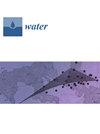水库的缩减:对土坝渗流条件和稳定性的影响
IF 3
3区 环境科学与生态学
Q2 ENVIRONMENTAL SCIENCES
引用次数: 0
摘要
本文论述了土坝在水库水位发生变化时的可靠性和安全性。在水工建筑物的运行过程中,为了排除积水或应对紧急情况,通常必须降低水位。水位降低会改变渗流条件,如洼地表面、渗流梯度值和方向、渗流速率和体积水动力负荷。实际水利工程表明,这些变化可能会产生一些负面影响。较高的渗流梯度会导致结构上游斜坡附近出现渗流引发的变形。在缩减过程中产生的水动力荷载会降低大坝上游斜坡的稳定性,导致大坝垮塌。可以通过解决坝体和坝基的下渗问题来评估下渗的潜在后果。对这一问题的数值求解是基于使用 PLAXIS 2D 软件包的有限元法。由此获得的结果与使用有限元法进行局部变式计算获得的结果进行了比较。通过数值实验分析了影响最大渗流梯度值和土坝坡度稳定性的因素。提出了限制引水参数和确保结构安全运行的建议。本文章由计算机程序翻译,如有差异,请以英文原文为准。
The Drawdown of a Reservoir: Its Effect on Seepage Conditions and Stability of Earth Dams
This article addresses the reliability and safety of an earth dam in the case of a change in the reservoir water level. The water level must often be reduced to remove water or as a response to an emergency situation in the process of operation of a hydraulic structure. Lower water levels change seepage conditions, such as the surface of depression, values and directions of seepage gradients, seepage rates, and volumetric hydrodynamic loading. Practical hydraulic engineering shows that these changes can have a number of negative consequences. Higher seepage gradients can lead to seepage-triggered deformations in the vicinity of the upstream slope of a structure. Hydrodynamic loads, arising during drawdown, reduce the stability of an upstream slope of a dam and cause its failure. Potential consequences of a drawdown can be evaluated by solving the problem of drawdown seepage for the dam body and base. A numerical solution to this problem is based on the finite element method applied using the PLAXIS 2D software package. Results thus obtained are compared with those obtained using the finite element method in the locally variational formulation. A numerical experiment was conducted to analyze factors affecting the value of the maximum seepage gradient and stability of the earth dam slope. Recommendations were formulated to limit the drawdown parameters and to ensure the safe operation of a structure.
求助全文
通过发布文献求助,成功后即可免费获取论文全文。
去求助
来源期刊

Water
WATER RESOURCES-
CiteScore
5.80
自引率
14.70%
发文量
3491
审稿时长
19.85 days
期刊介绍:
Water (ISSN 2073-4441) is an international and cross-disciplinary scholarly journal covering all aspects of water including water science and technology, and the hydrology, ecology and management of water resources. It publishes regular research papers, critical reviews and short communications, and there is no restriction on the length of the papers. Our aim is to encourage scientists to publish their experimental and theoretical research in as much detail as possible. Full experimental and/or methodical details must be provided for research articles. Computed data or files regarding the full details of the experimental procedure, if unable to be published in a normal way, can be deposited as supplementary material.
 求助内容:
求助内容: 应助结果提醒方式:
应助结果提醒方式:


